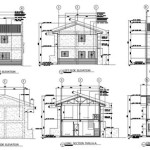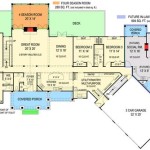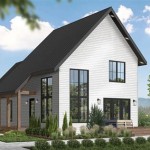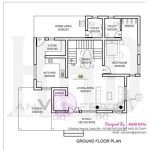```html
Open Concept Floor Plans for Small Houses: Maximizing Space and Light
In the realm of residential design, the open concept floor plan has become increasingly popular, particularly for small houses. This design approach, characterized by the elimination of walls separating common living spaces such as the kitchen, living room, and dining area, offers a multitude of benefits that are especially advantageous in compact dwellings. The strategic application of an open concept layout can significantly enhance the perceived size of a small house, improve natural light distribution, and foster a more connected and sociable living environment. However, careful planning and execution are crucial to ensure that the open concept seamlessly integrates with the specific needs and dimensions of the small house, avoiding potential pitfalls such as noise pollution and lack of privacy.
The allure of an open concept floor plan lies in its ability to overcome the limitations inherent in small spaces. Traditional layouts often compartmentalize areas, creating a sense of confinement and hindering the flow of movement and interaction. By removing interior walls, an open concept design creates a unified, expansive area that feels larger and more inviting. This is particularly beneficial for small houses where every square foot counts, and maximizing the perceived volume of the space is paramount.
Enhanced Spatial Perception and Usability
The fundamental advantage of open concept floor plans in small houses lies in their capacity to enhance spatial perception. The absence of walls between the kitchen, living room, and dining area creates an uninterrupted visual field, allowing the eye to travel freely and perceive the space as larger than it actually is. This effect is further amplified by the strategic placement of furniture and the use of a consistent color palette throughout the open area. Light colors, in particular, are known to reflect more light and contribute to a brighter and more airy ambiance, enhancing the feeling of spaciousness.
Beyond visual perception, open concept floor plans also improve the usability of small houses. The elimination of walls allows for greater flexibility in furniture arrangement and enables occupants to utilize the available space more efficiently. For instance, a kitchen island can serve as both a food preparation area and a casual dining space, eliminating the need for a separate dining table in very small homes. Similarly, the living room area can be easily adapted to accommodate different activities, such as entertaining guests or pursuing hobbies.
In smaller homes, the benefits of improved usability often outweigh potential drawbacks. A single, well-designed space can function as multiple distinct zones, each with its own purpose but contributing to the overall feeling of openness and connectivity.
Improved Natural Light Distribution and Ventilation
Another significant advantage of open concept floor plans in small houses is the improvement in natural light distribution and ventilation. In traditional layouts, interior walls often block natural light from reaching the inner areas of the house, resulting in dark and gloomy spaces. By removing these barriers, an open concept design allows natural light to penetrate deeper into the house, illuminating the entire living area and reducing the need for artificial lighting during the day. This not only saves energy but also creates a more cheerful and inviting atmosphere.
Furthermore, open concept floor plans can facilitate better natural ventilation. With fewer walls obstructing airflow, air can circulate more freely throughout the house, promoting a healthier and more comfortable indoor environment. This is particularly beneficial in small houses, where proper ventilation is crucial for preventing the buildup of moisture and odors. Strategically placed windows and doors can further enhance cross-ventilation, creating a natural breeze that cools the house in the summer and reduces the reliance on air conditioning.
The benefits of improved natural light extend beyond mere aesthetics. Studies have shown that exposure to natural light can improve mood, reduce stress, and enhance overall well-being. In small houses, where occupants may spend a significant amount of time indoors, maximizing natural light is particularly important for creating a healthy and uplifting living environment.
Enhanced Social Interaction and Connectivity
Open concept floor plans foster a more connected and sociable living environment. The absence of walls between the kitchen, living room, and dining area allows family members to interact more easily while engaging in different activities. For instance, a parent can prepare meals in the kitchen while keeping an eye on children playing in the living room, or friends can converse freely while cooking and dining together. This enhanced sense of connection can strengthen family bonds and improve overall quality of life.
Moreover, open concept floor plans are ideal for entertaining guests. The seamless flow between different areas allows for a more fluid and interactive social experience. Guests can mingle freely without feeling confined to a single room, and the host can easily participate in conversations while preparing food or drinks. This makes open concept floor plans particularly well-suited for small houses that are used for frequent gatherings and social events.
However, it is important to consider the potential for noise pollution when implementing an open concept floor plan. Without walls to buffer sound, noise from one area can easily travel to another, which can be disruptive, especially in small houses. Careful planning and the use of sound-absorbing materials, such as rugs and curtains, can help mitigate this issue.
Considerations for implementing this design in a smaller sized home requires careful thought. Firstly, storage is critical. In any small space, effective storage solutions are important, but this is even more so in open-plan designs. Integrated storage furniture, built-in shelving, and clever use of vertical space are all valuable tools. Secondly, is noise control. As mentioned previously, noise can travel more easily in open spaces. Consider using soft furnishings, rugs, and strategically placed furniture to absorb sound. Finally, consider the visual cohesion. This means maintaining a consistent color palette and style throughout the open area to create a sense of unity and avoid a cluttered or disjointed appearance.
Ultimately, the successful implementation of an open concept floor plan in a small house requires a careful balance between maximizing space and light, and maintaining a comfortable and functional living environment. By understanding the advantages and challenges of this design approach, and by planning carefully and paying attention to detail, it is possible to create a small house that feels spacious, inviting, and well-suited to the needs of its occupants.
```
Open Concept Two Bedroom Small House Plan Other Examples At This Link Plans Tiny Floor Sims

10 Small House Plans With Open Floor Blog Homeplans Com

10 Small House Plans With Open Floor Blog Homeplans Com

Modern Small House Plans And Design Ideas Floor Plan Open Concept Kitchen Living Room Guest One Bedroom

Single Story House Designs Open Plans Concept Floor

10 Small House Plans With Open Floor Blog Homeplans Com

Small Cottage House Plans With Modern Open Layouts Houseplans Blog Com

Open Concept Layouts For Small Kitchens
10 Small House Plans With Open Floor Blog Homeplans Com

Family Home With Small Interiors And Open Floor Plan Bunch Interior Design Ideas








